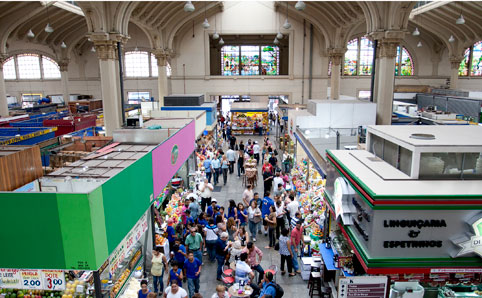Rinconcito Peruano
1195m

The Mercadão is a laboratory of the edible, spanning all of the city’s most important ethnic cuisines and displaying an incredibly colourful array of fruits and vegetables. It opened on 25 January 1933, and was located alongside the Tamanduateí and Anhangabaú rivers, which in pre-automobile days were the farm-to-market highways. The areas around the market have long since gone to seed, but the market itself recovered from its nadir in the 1970s and was completely restored in 2004.
If you’re the kind of traveller with a knack for safely packing glass jars in your suitcase, you may find some unique treasures. The upper level of the market also has several sit-down joints for lunch with a view of the action.
There’s an abundancy of native fruits, as well as exotic offerings from Asia, and if you linger interestedly at a fruit stall, you'll be invited to taste a piece of pitaya, mamey or mangostim.
The famous bacalhau (Portuguese-style salt-cod), with an aroma of olive oil and a melt- in-your-mouth quality, is a Mercadão favorite. It can be experienced in the form of a pastry at Hocca Bar, as well as at other shops further into the labyrinthine market.
The Italian mortadela sandwich is the signature item at the Bar do Mané, one of the oldest shops in the market. The generous sandwich is nearly piled as high as the snaking queue that forms for it on weekends. The bar serves up between 800 and 900 mortadela orders each day, but it’s just one of countless stalls in the market where your jaw may be knocked out of alignment attempting to open wide enough to handle the standard height of the sandwich.
A trip to the market is often combined with cheap shopping on Rua 25 de Março. Arrive at Metrô São Bento around 11am, take a walk around the chaotic street bazaar of Rua 25 de Março, and then it’s just a short jaunt over to the Mercadão for lunch – a typical Paulistano Saturday.
1195m
1436m
1517m
1665m
1755m
598m
742m
1319m
1644m
904m
1085m
1120m
1125m
1160m